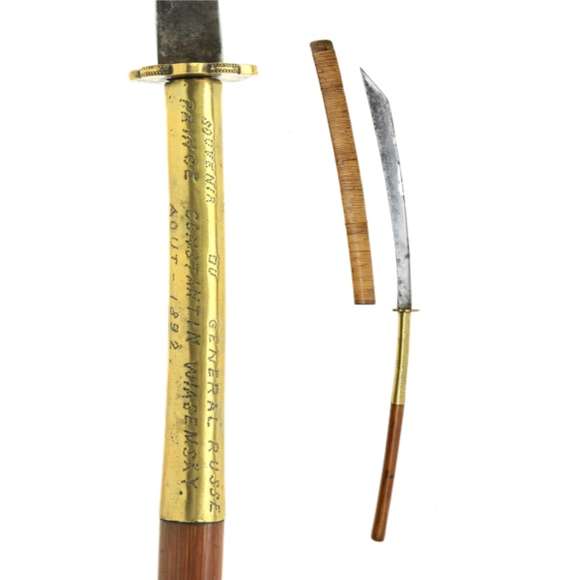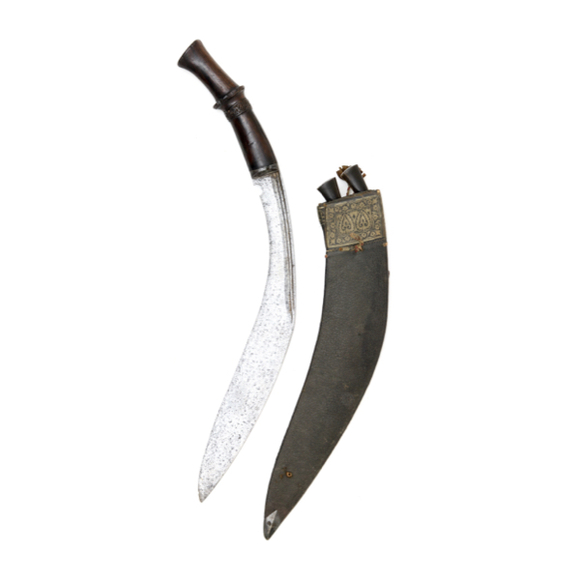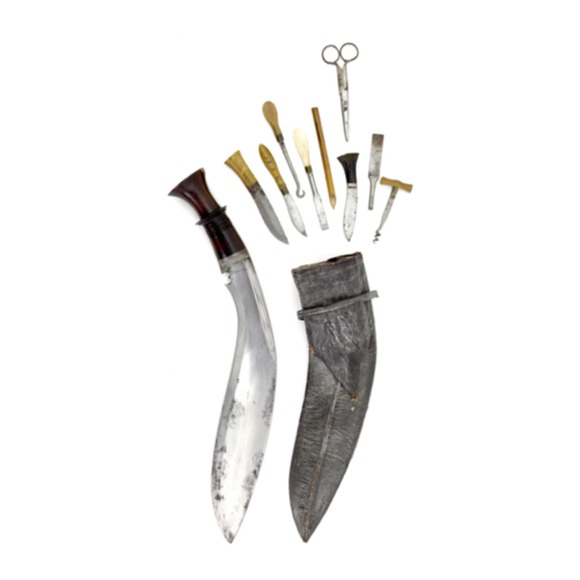Description
Prince Constantin Wiasemsky was a Russian aristocrat who sold his estate to pursue a life traveling Asia on horseback.
He would have remained unknown to me, had it not been for a Vietnamese Montagnard sword I purchased that had his name on it.

The Wiasemsky dha.
Purchased by Mandarin Mansion in 2020.
Background
By David Leffmann
In May 1891 a short note appeared in the French newspaper Le Figaro, under the heading “An Eccentric New Journey”: Prince Constantin Wiasemsky was planning to spend the next three years crossing Asia on horseback, and anyone interested in joining him should write to 50 Povarskaya Street, Moscow – one of the city’s most exclusive addresses.

50 Povarskaya Street, Moscow.
Ordered by Prince Boris Vladimirovich Svyatopolk-Chetvertinsky, a famous horse breeder.
Built by architect Pyotr Samoilovich Boytsov and contractor A.G. Vincent 1887-1889.
It was used for Masonic meetings under the prince who was a Mason and fan of Western culture.
In the 20th century it became the Central House of Writers, now Restaurant CDL.
Konstantin Alexandrovich Vyazemsky (Константин Александрович Вяземский) – or, as he was known in France, Wiasemsky – was born in 1853 into an aristocratic Russian family. A graduate of the renowned Imperial Page Corps, Wiasemsky could have looked forward to a life of cultured ease amongst the Russian elite, but instead horrified his contemporaries by selling up his hereditary estates in 1880, and embarking on a lifetime of travel.
When later asked what inspired his journeys – which took him across Europe, Africa, the Middle East, Russia and through China into Southeast Asia, Wiasemsky replied simply that “the purpose of my whole life is to travel”. Unfortunately, this attitude saw Wiasemsky ostracised from Russian society and, because he received so little attention at the time, frustratingly little is known about life.

Prince Constantine Wiasemsky
Bibliotheque Nationale de France
Newly married, he began his first trip in December 1881, traveling with his wife to Morocco, Algeria, and Tunisia. He was treated well by the sultan of Marrakesh, but disappointingly the town looked “no different from the rest of the empire's cities, which are generally ugly... they have neither luxurious mosques, as in the East, nor high minarets.” In 1883 Wiasemsky returned to north Africa, reaching Sudan before heading home via Iraq, Kurdistan and Armenia.
In 1891, he failed to attract funding from the Russian Geographical Society for what was, in their opinion, an impractical-sounding expedition on horseback to the far east. Undaunted, he went anyway, leaving Moscow on 6 July. He rode a troika through Siberia to Tomsk, which he caustically described as a mean and dreary city, then “purchased a dozen horses, and thus traversed the rest of Siberia. When I entered Mongolia, on Chinese territory, I was accompanied by Captain Zarembo, an interpreter, a photographer, a cook and a few Cossacks.”
This guard wasn’t enough to stop the party being attacked by bandits while following an old route through the Gobi Desert; they escaped “only thanks to the speed of our horses”, and not before Wiasemsky had been shot through the leg. He spent the next month being carried in a stretcher, reaching Beijing on 21 September.
Having recovered, they headed south through China, most of the time still on horseback, but occasionally resorting to river steamers. Impressed by how different everything was from Russia and Europe – the art, temples, cities, theatre – Wiasemsky spoke with as many Chinese people as possible, from local officials to farmers and peasants. He was especially struck by the level of artistry, writing that “even the smallest merchant decorated his shop with drawings and carvings with such taste that you will not see in our millionaires.” He was less impressed by the ever-intrusive crowds (who on one occasion pelted him with rocks), and the scale of corruption amongst officials – but realized it was inevitable, given their pitifully small salaries.
In March 1892 Wiasemsky crossed into Vietnam, then a French protectorate, where he was welcomed by the administration; the nominal ruler, Thành Thái, quizzed him about Russia and appointed him an honorary official. Wiasemsky was highly critical of the French opium trade – the drug was produced in Vietnam for sale to China – which he denounced as morally indefensible.
Next came Laos, and a rafting trip down the Mekong to Pakse. His journals comment on everything he saw between here and Thailand: Phnom Penh, Angkor, the people, plants and wildlife, architecture, customs, religion, slavery, the wealth of the various rulers. In Thailand, he decided to exchange his faithful Siberian ponies for local elephants, “because in the daytime they clear the roads of all incumbrance and at night protect caravans against tigers”. He visited Bangkok and Phimai ruins, which weren’t properly surveyed for another decade; on leaving the country he wrote wistfully that Thailand “left me the most pleasant memories ... people there are kind and hospitable, nature is luxurious, the sun is warm, there are plenty of fruits, and no trace of cold or frost."
Still riding an elephant, he spent the rest of 1892 “following the course of the Irrawaddy to Mandalay, then across the Manipur, Assam and Bengal.” In February 1893 he arrived at Calcutta where he found that the British, like the French in Vietnam, had made their lives in India as comfortable as if they were living in Europe.
Wiasemsky continued north into Tibet, where the temperature in June was twenty-one degrees below freezing. One of the very few foreigners to enter the country during the nineteenth century, he became friends with several monks: “The Buddhists are kind and hospitable, and I was able to unveil some of their secrets. I now understand the special regime by which they abstain from food and drink during a longer or shorter time. l am the only European who has the key to this mystery.”
It’s possible that rumors of Wiasemsky’s presence in Tibet contributed to British suspicions that Russia was meddling in local politics with a long-term objective of invading India, which led to the British punitive expedition to Lhasa of 1903–04.
Crossing back into Chinese territory, Wiasemsky steered northwest through the deserts of Xinjiang province, when he was again attacked by bandits. This time he lost all his luggage, including his souvenirs and important scientific specimens of plants and animals collected on his travels. One of his servants managed to alert the Russian Consul at Kashgar, who sent a party of Cossacks to rescue him.
So, with little solid material to show for his twenty-nine months on the road, Wiasemsky returned to Moscow in December 1893. The Russian Geographical Society predictably refused to promote or publish his notes and maps, but the following year he found widespread support in Paris: he was warmly applauded at the French Geographical Society, and told Le Figaro that he was already planning a major African trip: “I dream of crossing Africa in all its length, starting from Libya or Egypt and traveling through the Great Lakes region to reach the Zambezi and southern Africa!"
After his success in Paris, extracts of his travel diaries appeared in the popular Moscow journal Russian Review, and the Russian Geographical Society was finally shamed into making him a member. But in 1896, Wiasemsky suddenly withdrew from the world – possibly because of the death of his wife or, as Russian scandal had it, to escape from his creditors. He became a librarian at the Russian Orthodox Panteleimon Monastery on Mount Athos (then in Turkey, now in Greece), and remained there until his death in 1909.
His journals, kept at the Russian State Library, have never been published in full.
Sources
Вяземский, Константин Александрович. Russian Wikipedia article.
Русском обозрении (Russian Review magazine, 1894–1895)
Путешествие вокруг Азии верхом: Вьетнамские дневники
(Travels Around Asia on Horseback: Vietnam Diary. Institute of Oriental Studies of the Russian Academy of Sciences, Moscow 2011)
Le Figaro, May 1891. (From gallica.bnf.fr)
Благодер Юлия Гариевна: Записки князя К. А. Вяземского о путешествии по Китаю
(Blagoder Yulia Garievna: Notes of Prince K. A. Vyazemsky about a trip to China) Link to PDF.
Further reading
An article describing a lecture he gave in Paris was published in San Francisco Call, Volume 76, Number 10, 10 June 1894, written by Baroness Althea Salvador:







